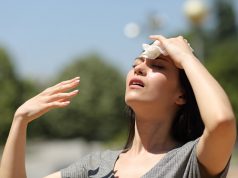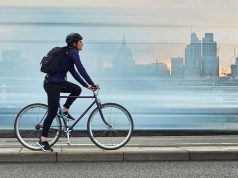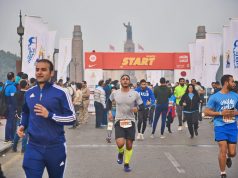By Harim Humayun
A happy-go-lucky chap with an enormous goal and the will to do it with style; Mahmoud Hussein has the urge to climb mountains (not just figuratively) to raise awareness for Crohn’s disease. Just back from his ascent to the summit to Mount Kilimanjaro, we sit down over a cup of coffee for some insight into the motivation behind it all.
CWM: Tell us about how this all started…
MH: Just to be clear, I have Ulcerative Colitis (UC). The difference between that and Crohn’s disease is that UC affects the large intestine while Crohn’s affects the whole digestive system. The thing is people don’t know how you get it or how you can get rid of it; you can only manage the illness. There are different levels with UC, with level 4 being the harshest; I had level 4. I had flare-ups that lasted like a week or two and you have bloody stool, you vomit everything, bad diarrhea, you cannot sleep, and painful stomach aches. So I had seven months of this, the flare-ups.
I was 17 when I was diagnosed. I had no idea what was going on with me. I remember being at my friend’s birthday party and I assumed I had stomach flu or something. I lost 5 kilos in one week. I was getting the wrong medication, I couldn’t move or sleep. My family was afraid, I was afraid. I was getting worse by the day; I could only eat a spoon of jello a day, that’s all I could digest. I was basically in and out of hospitals.
I stayed 8 months with the disease and then I had the colostomy. With UC, I was kind of lucky because you get to a point where if you can’t live with it you can do a colostomy; which is basically removing part of the colon or all of it, I removed all of it. It has to be done in stages. This is the thing in Egypt, everyone that I have been in touch with who have Crohn’s or UC, were all misdiagnosed in the beginning, including me.
How have you tackled it?
I managed to get my life in some sort of routine while managing this disease, I started school again, but I had to take time off now and then whenever I relapsed. Then I had the surgery, which is difficult and everyone was advising me not to do it. One doctor simply put it into perspective, he said if you cannot live with it, then just take the risk and do it. In the end, I was not the one making this decision, it was my parents and it worked out for the best, two years of my life had already been affected by this disease.
Do you feel that you have achieved things that you would not have tackled without having to cope with the illness?
I wanted to climb mountains at a very young age, before I became ill. I used to watch climber and adventurer Omar Samra who he has been such an inspiration. And then I was sick and he came to my school where I won a competition to go to Saint Catherine with him and I was supposed to travel with him. They had to postpone it due to the revolution. When he sent the email to set the date again, I was in the hospital, weighed about 35 kg and just had my colostomy. I remember thinking that I must go on this adventure! I told my parents and they right out refused. After this I started going to the gym, working on my lower body strength because that is what was going to get me where I wanted to go.
Tell us about some of your travels and adventures.
So far my biggest adventure has been the climb of Mount Kilimanjaro (19, 339 feet). I always wanted to climb mountains; it is a great mental and physical challenge. But after my illness and fighting it, I thought why not do it for a cause. Because while I was sick, I searched for people in similar position and illness as mine but there were very few and none in the Middle East. I wanted to relate to someone who has UC or Crohn’s so I actually want to do the 7 summits to raise awareness about the disease. My next adventure is climbing Mount Elbrus (18, 510 feet) in the coming summer.
What were the high and low points of your Mt. Kilimanjaro climb?
The route I took was 6 days – the Machame route. You can do it in 6 or 7 or 8 days, I chose 6 days as it is more challenging. I kind of regretted it halfway through as I had altitude sickness. I was unable to keep anything down and I ended up getting food poisoning also on the 3rd day. We spent around 15/16 hours hiking, really hectic day and all I could have was tea. I have no idea how I managed it. There were people just turning back around. But I had a goal and I kept moving, albeit at a slow pace.
So I managed to summit. I and my teammates had a very emotional moment up there. I just started crying, I couldn’t control it. It was an enormous sense of accomplishment. I had been working on getting there for 2 years, to go through so much and get there has been a satisfying feeling.
When did you decide to set up your Doaa page, and what are your goals?
The page is named after my mother. The whole point of the summit was to raise awareness about UC and Crohn’s. Right now it is only a Facebook page and climbing Kilimanjaro was only the first step. It is a platform for people who have UC and Crohn’s to get in touch with each other and to know that you are not alone. We do not have the stats in Egypt, but I assume there are plenty of people out there who have Crohn’s and UC and have been misdiagnosed. On the page, you can share your story, get in touch with me or meet me in person. I am looking to raise funds as the surgeries needed are really expensive. I have been in touch with a lot of doctors that are willing to help out.
How important is it to you to be a support and inspiration for young people, irrespective of any health issues?
Inspiration is such a big word. People have been so supportive ever since I started to tackle the illness and since starting the page. I am just very grateful for all the love and good wishes. It gets to a point where it motivates me to do more, to accomplish more. I believe that motivation comes from within and it was such a challenge to summit, it was really intense. I wanted to do it because at one point in my life I was helpless and climbing that mountain was my way of knowing that I could do anything.
Do check out the DOAA initiative page and help raise awareness: https://www.facebook.com/DoaaFoundation/about/?entry_point=page_nav_about_item&ref=page_internal







